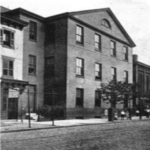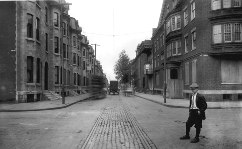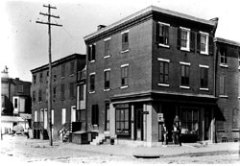History of the Fitler Square Neighborhood
From the city’s earliest history, the Fitler Square neighborhood was a shipping, shipbuilding and brick-making center that became home to some of the city’s most prominent citizens. While the majority of the buildings in the neighborhood date from the mid-19th to the early 20th century, the history of the neighborhood’s development can be traced through the changing styles of its remarkably varied architecture.
 T piece was expanded by Tony DeAnnuntis from an article by George Malcomson. Several of the photos on this page are provided courtesy of the Library Company of Philadelphia, and with the assistance of Charlene Peacock, Prints Department. Most of the pictures you can click on for a larger version.
T piece was expanded by Tony DeAnnuntis from an article by George Malcomson. Several of the photos on this page are provided courtesy of the Library Company of Philadelphia, and with the assistance of Charlene Peacock, Prints Department. Most of the pictures you can click on for a larger version.
A textile-manufacturing and transportation center, the neighborhood grew with the westward expansion of the city through the 19th century. And its history mirrors the evolution of Philadelphia into America’s most important manufacturing center, and then its decline.
From the city’s earliest history, the banks of the Schuylkill River provided a vital alternative to the Delaware as a point of shipping for the farms and residences on both sides of the river in the Colonial period.
But in the 1830’s and 1840’s the wharves along the Schuylkill became the first transfer point for the coal coming to the city from the mines upstream. Meanwhile during the same period, arriving Irish immigrants began to make the neighborhood their home, taking the steevedore jobs that resulted from the expanding coal trade, as well as finding textile and weaving work, as others had done in Kennsington through numerous private shops for the looms of individual weavers, as well as rug and cloth-making factories. The neighborhood at this time was rough-and-tumble, and the few opportunities for poorly paid work did little to assuage rampant poverty in the area. And because of frequent recessions and economic depressions into the early 20th century, even that work sometimes seemed to disappear almost overnight. In addition to the larger three-and-four story residences in the area, the Fitler Square neighborhood boasts numerous small streets whose serene beauty is the result of the cooperation and hard-work by the residents. So it is difficult to recall that small, charming houses lining delightful streets like Panama, Naudain and Addison were once the homes of factory workers working twelve-hour days, and that those workers included women as well as children as young as ten years of age.
By the 1870’s, the increasing size of ships made docking along the relatively shallow Schuylkill less and less profitable. And when the Reading Railroad began to haul its coal east to the Delaware docks at Port Richmond, the Schuylkill’s value as a port quickly declined. Thus it was around this time that the neighborhood began to slowly change to one of primarily residential housing.
Over time the neighborhood  became the home of some of the city’s most prominent citizens. The historical residences include the home of the naturalist Edward Drinker Cope (two blocks east of the Square on Pine Street), the home and then library and museum of the Rosenbach brothers (on Delancey Street near 21st) and the home of the popular war journalist and novelist Richard Harding Davis (on 21st Street just south of Walnut). And a few blocks south and west of the Square lies the Naval Home, a designated historical site which itself is adjacent to the site of a major 19th century US Naval Base and Shipyard.
became the home of some of the city’s most prominent citizens. The historical residences include the home of the naturalist Edward Drinker Cope (two blocks east of the Square on Pine Street), the home and then library and museum of the Rosenbach brothers (on Delancey Street near 21st) and the home of the popular war journalist and novelist Richard Harding Davis (on 21st Street just south of Walnut). And a few blocks south and west of the Square lies the Naval Home, a designated historical site which itself is adjacent to the site of a major 19th century US Naval Base and Shipyard.
Fitler Square itself was created from a former brickyard by city ordinance in 1896. It was named to honor Edwin H. Fitler, a popular mayor of Philadelphia from 1887 to 1891. Among his many distinctions, he had been elected for his single term by the widest majority of voters up to that time.
At the turn of the 19th century,  Fitler Square boasted pleasant pathways and shading sycamores and elms. By the early 1920s, however, the park and much of the neighborhood that surrounded it had slowly deteriorated. But a member of the Fine Arts faculty of the University of Pennsylvania, James P. Methaney, saw the potential of the area. He built a home for his family at 2420 Pine Street and then persuaded Joseph H. Horn, one of the founders of Horn and Hardart, to do the same. The Horn mansion was completed in 1929 and still stands at 2410 Pine Street. Methaney died in 1948 and is remembered in the Square by a bronze plaque and memorial tree dedicated in 1968 by the Fitler Square Improvement Association.
Fitler Square boasted pleasant pathways and shading sycamores and elms. By the early 1920s, however, the park and much of the neighborhood that surrounded it had slowly deteriorated. But a member of the Fine Arts faculty of the University of Pennsylvania, James P. Methaney, saw the potential of the area. He built a home for his family at 2420 Pine Street and then persuaded Joseph H. Horn, one of the founders of Horn and Hardart, to do the same. The Horn mansion was completed in 1929 and still stands at 2410 Pine Street. Methaney died in 1948 and is remembered in the Square by a bronze plaque and memorial tree dedicated in 1968 by the Fitler Square Improvement Association.
Meanwhile, attracted by the diverse housing stock available ranging from tiny early-1800’s trinities to substantial Victorian town houses other newcomers followed.
The majority of the buildings of the neighborhood date from the mid-19th to the early 20th century, and the history of the neighborhood’s development can be traced through the changing styles of its remarkably varied architecture.
The evolution of the neighborhood slowed during the Depression, but the pace picked up after the end of the Second World War.
Newspaper article: Fitler Park, Beautified By Civic Club, Increases Property Values in Area (March 1949)
In 1953 the Square caught the eye of the Center City Residents’ Association, whose members asked local architect Norman Rice to draft a rehabilitation plan.
Newspaper article: ‘Little Pentagon,’ Lots of Ivy Give Fitler Square New Look (September, 1954)
However, within a few years the only things left of Rice’s work were some firethorn shrubs and the brick guardhouse. Vandals destroyed or stole other plantings, mutilated benches, and did their best to rip up brick seating areas, the carefully-planted ivy and most of the new small shrubs.
Aroused residents formed the Fitler Square Improvement Association, which was incorporated in 1962. The organization is dedicated to raising money for maintenance and enhancement of the park, supplementing the funds provided by the Department of Recreation.
In 1981, Fitler Square again underwent major restoration. Under the leadership of Mrs. John F. Wilson, founder and president of the Fitler Square Improvement Association, brick walkways were added, new lighting was installed, and the park was enclosed within an attractive wrought iron fence. A Victorian cast-iron fountain and pool in the center of the Square, originally installed in 1976, is now dedicated to the memory of Mrs. Wilson. In 1982, a sculpture by Gerd Hesness, entitled “Fitler Square Ram,” was installed in the eastern end of the park. In 1983, a sculpture by Eric Berg, entitled “Grizzly,” was placed in the western end. And, in 1989, a third sculpture, “Family of Turtles,” also by Eric Berg, was dedicated, having been donated by Mrs. David Kaufman.
Annuual membership dues and proceeds from the yearly Spring Fair, started in 1963, make possible new plantings, professional feeding, care of the trees, seasonal changes of flowers and additional custodial care when necessary. In addition to the Fair held in May, the Association sponsors an Easter Egg hunt, an annual Christmas tree lighting ceremony and carol songfest, and a number of volunteer work days throughout the year when residents pitch in to help spruce up the Square.